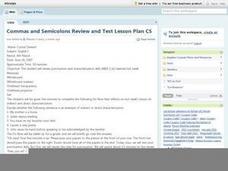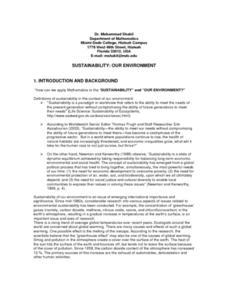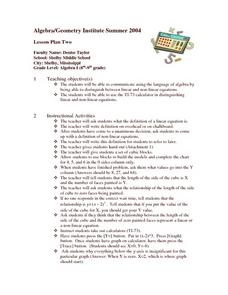Curated OER
Jack Math Scramble
Students practice throwing and catching jacks to improve their hand-eye coordination. In groups, they participate in a variety of games in which they use the jacks to improve their problem solving skills. To end the lesson, they pick up...
Curated OER
Natural Disasters
Ninth graders write a description of a natural disaster. They list as many natural disasters as they can think of. The class discusses any natural disasters individuals have witnessed first hand. They watch a brief clip of a film that...
Curated OER
Language Arts: Solch Sight Words
First graders recognize Dolch sight words on cards and texts. They practice the selected words by creating short sentences. After reading different fables, 1st graders create their own illustrations to accompany the stories. Once they...
Curated OER
COMPARE SOILS BY GROWING PLANTS
The student will identify the difference in the rate of plant growth in three soils that vary in organic matter.1. Obtain three to four flowerpots, different types of soil, a record chart, three to five beans for each pot, and water....
Curated OER
Interior Design: Form Vs. Shape
Students discover the difference between form and shape as it pertains to interior design. After identifying objects as either shapes or forms, they design their own shapes and give them form. Activities include creating shapes and...
Curated OER
Storage Hunt
Students create visual examples of each type of storage that should be found incorporated throughout the home. They also visually identify the difference between built-in storage and furniture storage. Students then create two collages...
Curated OER
Fibers
Young scholars examine the difference between natural and synthetic fibers. They correctly match natural and synthetic fibers by playing with fiber game cards. They work as a group to put the fibers into the correct categories.
Curated OER
Language Arts: Punctuation and Characterization
Students prepare for a test on punctuation and characterization by completing practice assignments. While completing the assignment, they note the difference between direct and indirect characterization and explain how punctuation...
Curated OER
Multiple-Meaning Words
Eighth graders answer a riddle to explore multiple meanings in words. After discussing the riddle, they match the definition on their card with another student who has the word. Students use their words with different meanings in...
Curated OER
Paraphrasing
Seventh graders practice paraphrasing. As a class, they review previous lessons and discuss the difference between paraphrasing and plagiarism. Students begin by paraphrasing sentences orally and then they complete a worksheet,...
Curated OER
Fact vs. Opinion
Students explore fact versus opinion in reading material. They listen to sentences and use hand signals to identify if the sentences are facts or opinions. After reading a story, they vote on sentences for facts and opinions and stae a...
Curated OER
Sustainability: Our Environment
Young scholars explore the sustainability of our environment, the trend in rising temperatures and the emission of greenhouse cases. Using given data, students test and construct a confidence interval and the difference between two...
Curated OER
I Scream for Ice Cream!
Students determine that correspondences appear differently in different words. They discover the difference between long and short vowels and that these correspondences are spelled and pronounced differently. They review the i=/i/ and ...
Curated OER
Respecting Differences
Students move around the room to express opinions on specific questions. In this opinions lesson, students explore their feelings about the opinions they express.
Curated OER
Using Inequalities to Problem Solve
Students explore inequalities. For this Algebra I lesson, students solve and graph linear inequalities involving addition, subtraction, multiplication, or division. Students use inequalities to solve and graph real-world problems.
Curated OER
Holiday Shopping
Fourth graders find change for an amount given. In this real life subtraction lesson plan, 4th graders use an advertisement to select items to "buy." They figure out how much money they would pay the cashier and how much money they will...
Curated OER
Investigation - The Bakery Shop
Students participate in mathematical music and subtraction using their fingers when indicated in the song. In this music/math lesson, students count their fingers and pretend their fingers are cookies. Students sing the song and put a...
Curated OER
Airplane Propeller
Students examine the different kinds of propellers and their functions. In this airplane lesson students build a hand made propeller.
Curated OER
Are There Really Fifty-Three Nations Within Africa?
Students color a map showing that Africa consists of 53 nations and recognize the difference between a nation and a continent. The main objective of this lesson is for students to realize that Africa is a continent with many nations...
Curated OER
Moving Along With Simple Machines: Introduction
Students observe examples of gravity, friction, and force on the playground. They then experiment and participate in a variety of activities in centers back in the classroom.
Curated OER
Exploring the Interstellar Medium
Students investigate the Interstellar Medium and the Local Bubble that the Sun is inside. They read and discuss a handout, answer discussion questions, observe a demonstration of light scattering, and conduct an experiment on the...
Curated OER
"The Outsiders" by S.E. Hinton
Middle schoolers estimate the distance in miles between Tulsa, Oklahoma and Manhattan, Kansas. They gather and graph data on gangs in both areas.
Curated OER
To Tell the Truth
Students participate in a discussion designed to help them discern the truth from lies. They discuss picture cards and make true and false statements regarding the information on the cards. Students also listen to various fables about...
Curated OER
Linear and Non-Linear Equations
Students study linear and non-linear equations. After a teacher demonstration, they use calculators to solve and graph equations. They distinguish the difference between linear and non-linear equations.

























